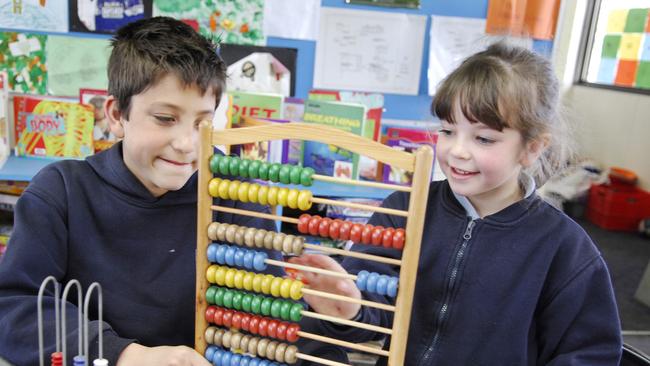Programs to help kids who fall behind in maths do more than add up

It’s well documented that overall levels of student achievement in Australia have been in decline – or at best have stagnated – over recent decades.
A concerning number struggle to achieve at the most basic level – with mathematics a persistent and under-appreciated weakness. About 400,000 Australian students each year (one in 10) are below the lowest international benchmark in mathematics, and require additional support if they are to succeed.
Many children who perform poorly in maths in the first few years go on to suffer a cycle of failure that can be very difficult for schools to reverse. That’s because struggling to grasp the basics in the early years can trigger problems with self-esteem, motivation and anxiety. If not addressed quickly, children avoid maths, disengage in class, don’t do homework, and do less practice – ultimately compounding their difficulties.
Early identification of children with numeracy weaknesses can provide the opportunity for intensive, targeted intervention while the achievement gap is narrow and before there is any damage to self-esteem or motivation.
However, the school system at large has generally failed to provide the education safety net needed for struggling students. Arguably the most damning statistic in the education system is that four out of every five children who fall behind never catch up to reach proficient levels.
Improving the school system’s report card on student catch-up is critical and urgent.
It will take both improvements to identifying children at risk of falling behind and ensuring the support provided them is rapid and intensive enough to turn things around.
First, we must more systematically provide early maths screening.
In the health system, the population is routinely screened to identify conditions that might put at risk our wellbeing - we don’t wait for symptoms to appear. School systems should work similarly.

Rather than wait for children to fail (such as in their NAPLAN tests in year 3), timely, effective screening will identify those at risk much sooner.
This would help teachers know when intensive processes are needed, and support them to use instructional time to maximise their impact on student learning.
Over recent years, most school systems have moved to universally screen for early reading skills, particularly the Phonics Screening Check. This brief, simple survey accurately identifies which students struggle to correctly map letters, and combinations of letters, to sounds – a foundational skill that underlies learning to read.
A comparable approach is possible in maths, but requires the support of efficient, informative, accurate and universal screening of core numeracy skills in year 1.
Over recent years, independent reports to education ministers have highlighted the need for an evidence-based universal early numeracy screening approach, with a particular focus on year 1.
However, today’s approaches to assess early numeracy aren’t fit for screening purposes. They demand teachers spend considerable time completing individual and detailed assessments with each child, which can result in precious class time being diverted from teaching.
Testing also doesn’t focus on the right skills and knowledge that reliably predict later maths success. Less is more when it comes to universal screening – collecting only enough detail to predict risk without adding the burden of collecting information that doesn’t.
Second, getting screening right is only half the equation; intervention must be more effective.
Once at-risk students are identified, teachers and schools need strategies and resources to deliver evidence-based, intensive support to those students and monitor their progress to see how interventions are succeeding.
Over recent years, governments have invested significantly in school-based intervention – particularly small-group tutoring programs introduced to address student catch-up following school closures in NSW and Victoria.
Federal Education Minister Jason Clare has implied that such policies could soon be scaled up and supported nationally.
However, the inconvenient truth is that closing achievement gaps requires more than simply putting students into smaller groups.
Recent evaluations of the NSW and Victorian tutoring programs show that students receiving the additional intervention performed no better than similar students who didn’t.
That’s disappointing, but hardly a surprise, given there’s been little quality assurance to ensure gold-standard practices have been in place.
For intervention to work, the right children must be identified and placed into intervention groups, as early as possible, and given the highest quality instruction.
Aligning assessment to a systematic, multi-tiered framework of support is the best way to achieve this.
Good progress-monitoring tools can inform agile decision-making so adjustments can be made to ensure interventions are making an impact. This avoids waiting months – or years – to find precious time and resources have been misdirected into insufficiently rigorous approaches, as has been the case in our two most populous states. Time in school is a precious resource, and children are more precious still.
Our teachers need the support of efficient, evidence-based tools to identify difficulties early and give every student the opportunity to succeed.
Kelly Norris is a senior research associate at the Centre for Independent Studies and the author of Screening that Counts: Why Australia needs universal early numeracy screening.





Australia’s education system suffers from a “student catch-up crisis” that leaves too many children behind. Early and universal screening for educational risk is the ticket to improving these outcomes.